Grooming a dog well is a much-needed requirement for any dog owner and dog nail trimming is a very crucial part of that process.
Having well-trimmed nails is an indication of your dog’s good health and hygiene. You can choose to cut your dog’s nails by yourself or like many fastidious owners, you can choose a professional groomer to do the job.
As for a fact, let us inform you that the procedure of dog nail trimming is an easy one. Adjust your puppy for the nail trimming procedure from early on in his life as some dogs are anxious about the process.
A few dogs are okay with sitting on the owner’s lap or on flat-surfaced furniture, while a few dogs are more reluctant and need to be restraint during nail trimming.
We advise you to let your puppy have some peanut butter during the trimming process so that he finds it more comfortable to handle it.
Table of Contents
Why Should I Trim My Dog’s Nails?
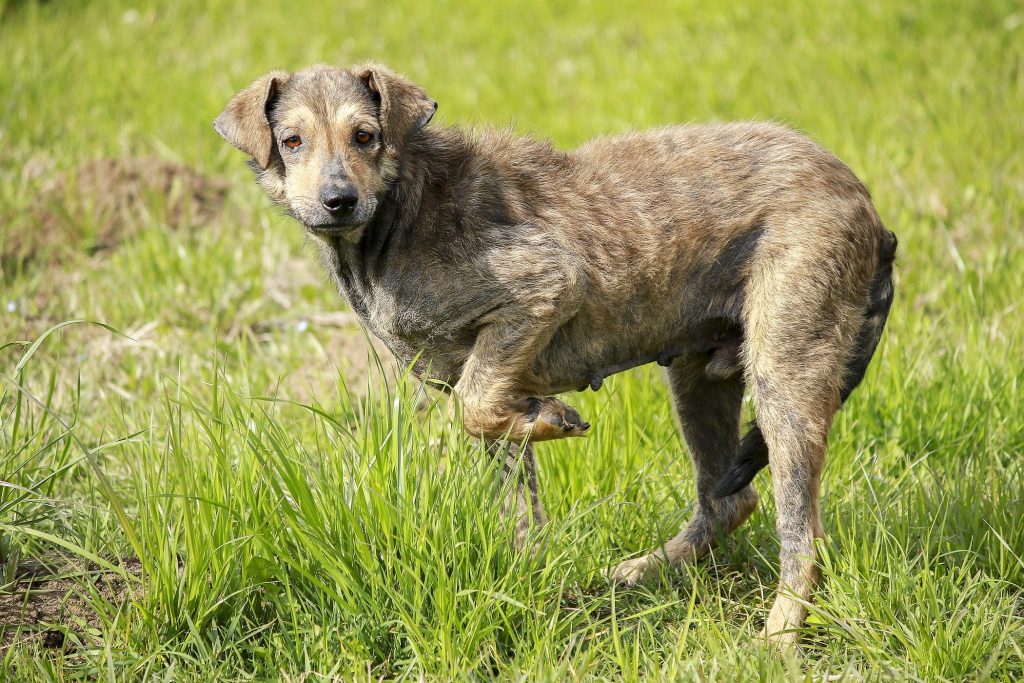
Nails that have grown oversized can lead to severe pain and can impact your dog’s life in a negative way.
It is a fact that the dogs who walk on hard ground like asphalt or concrete find it easier to regulate the length of their nails as compared to the dogs who tread on softer ground like a forest or park.
Other than the ground that your dog walks on, there are other factors as well that lead to the nail issue such as the activeness of your dog, feeding habits, the dog breed type, and genetic predisposition.
Not only can very long nails cause pain, but they can also lead to defects in your dog’s posture. This defect is caused by the dog transferring his weight to one side to avoid pain.
In severe cases, grave injuries can be caused or lameness can occur. In this scenario, the nails could grow relentlessly, sometimes even up to a length that they touch the ground.
Due to unhealthy and unkempt nails, your dog’s quality of life can get affected. You should take preventive measures as soon as you see your dog’s nails becoming big enough to touch the ground.
You should recognize that your dog’s nails are too long when you see that his nails touch the ground.
If there is a clicking sound made by the nails, or you see your dog’s nails turn on one side, then you must start the dog nail trimming procedure as soon as possible.
Extremely long nails can hamper your dog’s movement.
Trimming your Dog’s Nails
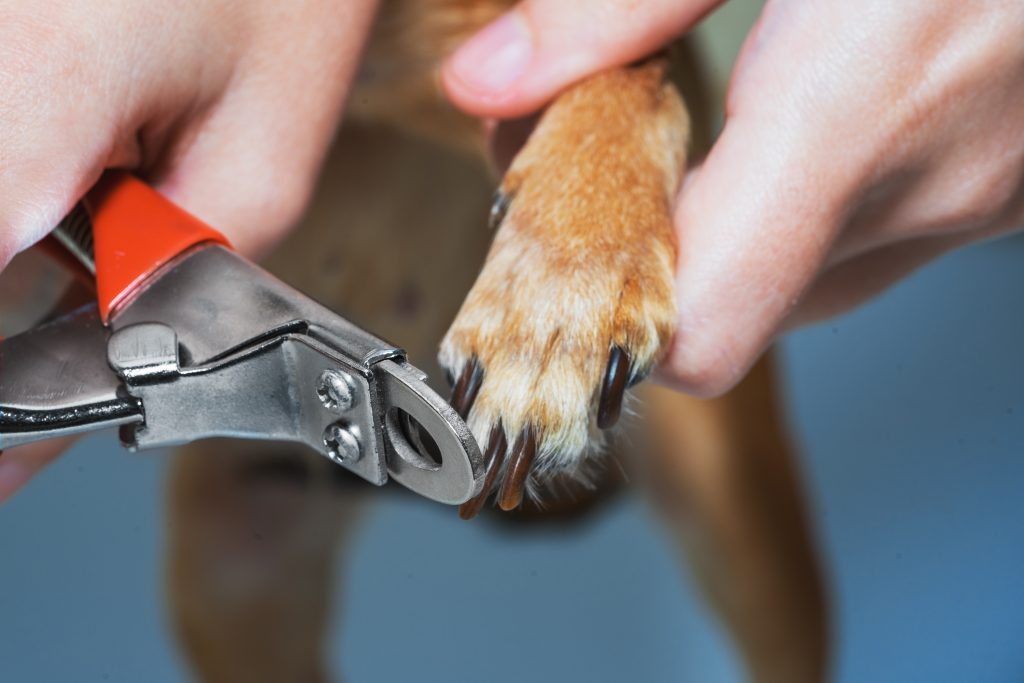
Almost all dogs would hate their feet being handled, so trimming nails may not always be as fun as you would have expected.
So, after the nail cutting procedure, feed your dog a tasty treat, along with a light embrace, and an affirmative gesture showing your acknowledgment.
Types of Nail Trimmers
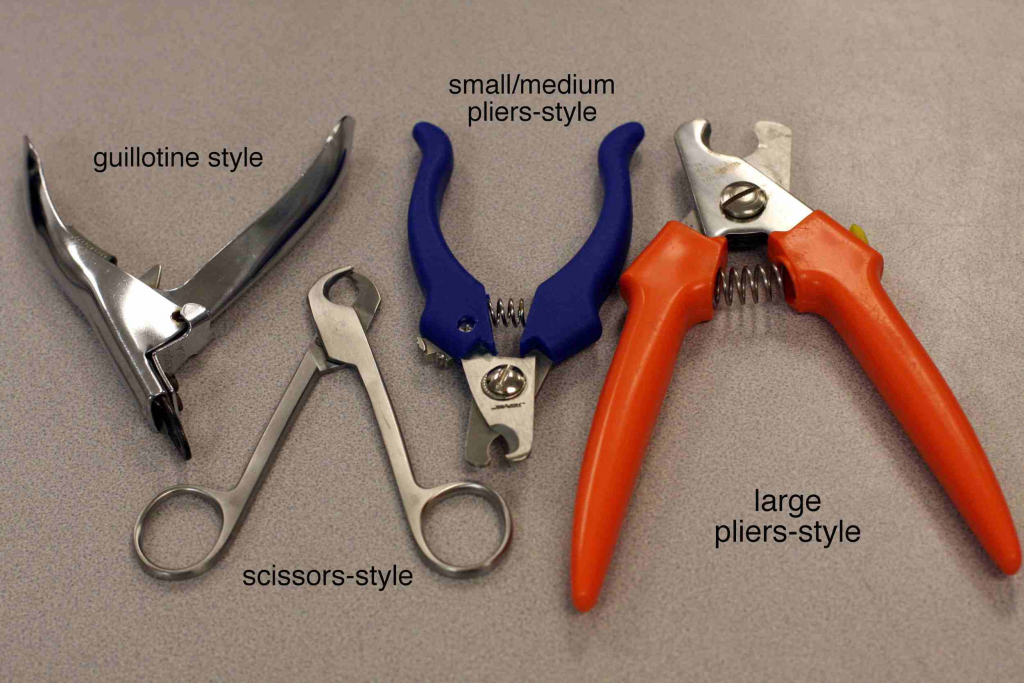
You will find many types of dog nail trimming instruments available in the market. The different kinds of tools include scissors, guillotine, grinders, and other clippers.
The type of clippers you choose depends on the level of comfort you and your dog have in using them.
We recommend you to select trimmers that have a sharp-edged blade that prevents crushing your dog’s nails.
The sharp-edged cutting blade ensures preventing the nail to be pulled or split. A filer can help your dog’s nail in getting more rounded and hence easier to cut.
The scissor trimmers work optimally for big dogs having thick nails, while guillotine trimmers are ideal for small to medium-sized dogs.
While using guillotine trimmers, attach the tip of your dog’s nail into the hole made by the blade, and apply pressure.
There are grinder tools available in the market also. However, they just provide a smooth finish to your nails and are most suitable for dogs who are fussy about having their nails cut.
It is recommended by experts to always have some styptic powder handy when your dog starts bleeding because of a nail cut too short.
We suggest you to consult a professional groomer or your veterinarian who would guide you on the length of trimming the toenails.
The toenail of the dog is composed of the quick, which is a pink tissue within his nails. It supplies the nails with blood. You should avoid cutting the quick as it may start causing profuse bleeding due to its sensitivity.
You do not need to cut all your dog’s nails in one go. Doing one paw at a time is fine while keeping breaks in between and with other intermediate activities.
Follow the following process to trim your dog’s nails:
- Keep the foot of the dog stable while gripping it gently.
- Cut out a tiny portion of the end of every toenail.
Utilizing the scissors or guillotines, position a small bit of nail in the nail cutting instrument and clip.
If you feel the nail to be soft, halt immediately, as you might have hit the quick!
Stop the blood from oozing out.
If you injure the quick by clipping it inadvertently, your dog will become sad and a dirty state of bleeding may take place.
Due to the profuse bleeding nature of the quick, if you unintentionally cut it, you would need either a styptic powder – something to be applied with a cotton swab or a nail cauterizer – a heat applying tool that prevents further bleeding.
Timely dog nail trimming will make the quick retreat back from the end. And, short sized quicks are ideal for the good health and easy maintenance of the dog.
Keep a moist washcloth handy to tidy up the blood and the styptic powder.
Quicking is so severe that the experience stays in mind for many years in the affected dogs.
If you choose grinders in place of clippers, then using the same methodology, hold gently the foot of your dog, switch on the grinder, and grind every nail bit by bit.
Know About Dew Claws
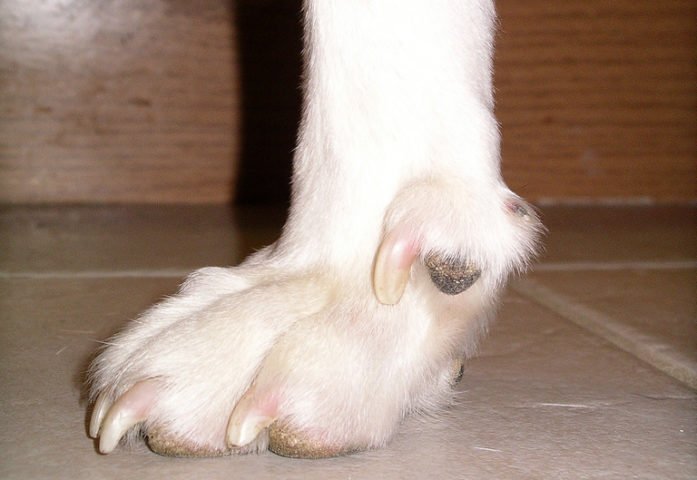
If your dog has an extra nail, called a dewclaw, these nails can grow pretty long because they don’t touch the surface of the ground.
If you miss cutting dewclaws, they could subsequently grow back into the dog’s foot, and this can be severely painful for him.
Long claws of some dogs tend to develop into the toe-pad. This is especially the case for dewclaws.
Dewclaws do not wear down because they do not touch the ground. They are connected to the leg by loose skin.
They can be twisted away from the leg to let guillotine clippers fit into them.
Always keep in mind to clip the dewclaws situated on the inside of the paw unless they were previously removed during puppyhood.
A few large breeds of dogs such as the St. Bernard have 2 groups of dewclaws on their hind feet.
Some Quick Tips
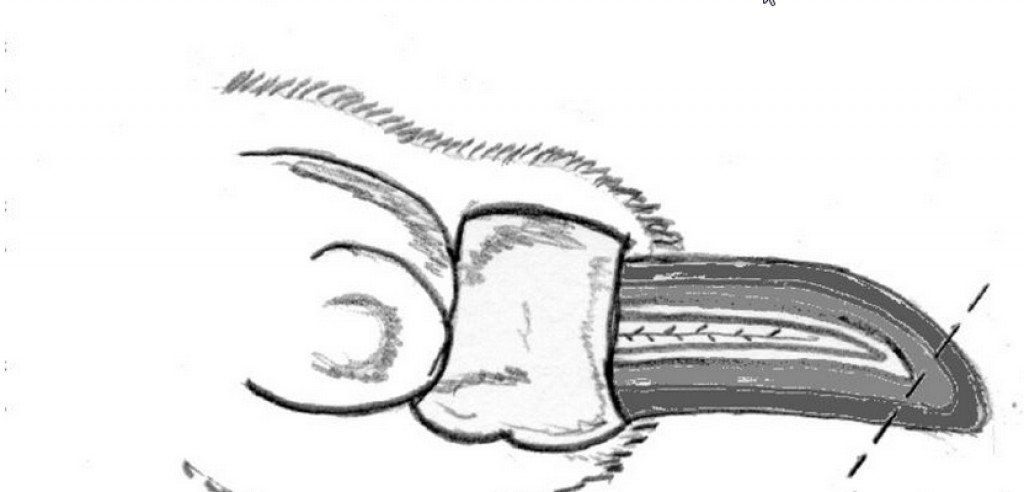
We list below some easy to follow tips and things to keep in mind during the activity of dog nail trimming:
- Do not squeeze the toes while trimming as that could hurt the dog.
- Always link dog nail trimming with giving them treats. That makes for a relatively enjoyable experience for your dog.
- The recession of the quick due to nail shortening will facilitate further trimming as the quick will recede each time the nail is cut.
- If you inadvertently quick a dog nail, treat him immediately.
- When you place a clipper for clipping, ensure a parallel position to the nail.
- It is less difficult to observe the nail region on colored nails than on white nails.
- The nails should be trimmed in an open space or in a room that is well-lit.
- As a thumb rule, do dog nail trimming every two weeks for maintenance and every week for reducing the nail size.
- Use scissors with unsharpened edges to take out excessive hair of the toe. Toe hair causes inconvenience while trimming, so it’s better to take it out.
- To isolate the toes for trimming, utilize your fingers. Also, handle the paw gently.
- The nail to be cut will have a pale ring encircling it just around the quick.
- Cut the toenails by observing them minutely. Use your glasses if required.
- Make use of the best tricks and control you have to finish the initial phase successfully, even if your dog is an expert in dramatization.
- Begin cutting from the rear feet, because the nails are somewhat less sensitive and less lengthy than the front.
- If your dog moves too much during the dog nail trimming procedure, and it becomes difficult to control him, it is better to seek the help of the groomer.
- Make the dog nail trimming sessions fun by providing your dog with treats, kisses, and pats.













[…] Also see, How to trim dog nails easily […]
[…] nail clipping is a very important part of the grooming process for a dog and it should never be overlooked. If you ignore this task, your dog will attract pain and may end up […]
[…] should be checked with nail trimming and ear wax cleaning […]
[…] 5: Nail TrimmingRegular nail trimming is important. It helps your dog maintain a grasp of the ground and prevent him from slipping and […]